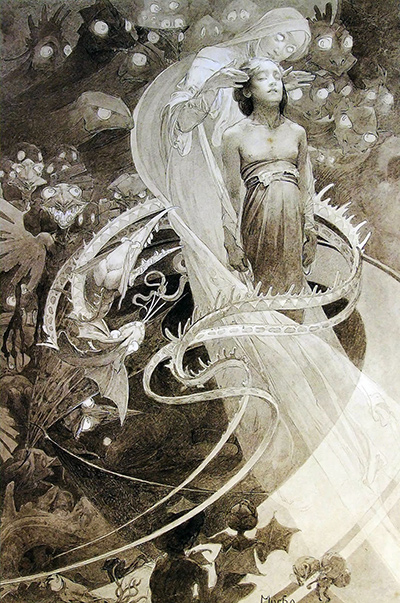Created by Mucha in 1899, Le Pater was published in an edition of 510 books, on 20th December 1899, in Paris
Le Pater was an illustrated book that represented the artist’s spiritual epiphany: this was the first Mucha painting about religion.
In the book that he considered to be his masterpiece, Mucha created an image for every line of the Lord’s Prayer, portraying his own interpretations of religion and his personal philosophy.
Mucha’s thinking led him to believe that Beauty, Truth and Love were the three cornerstones’ of humanity.
In the decade before the turn of the century, Alphonse Mucha is reported to have faced a crisis of faith. Two years before he published Le Pater, Mucha was initiated as an apprentice into the Paris Lodge of Freemasons.
After the independence of Czechoslovakia (his homeland), he was appointed Grand Master of the Freemasons of Czechoslovakia.
Despite his Catholic upbringing, and becoming a practicing Freemason, he also had a long-standing interest in Spiritualism since the 1890’s (it is reported that he conducted psychic experiments and séances).
Mucha analysed the model Christian prayer. He then condensed and reconstructed the seven verses into a set of three colour pages. Decorated with Masonic symbolism, all three pages are decorated with symbolic flowers, borders and a sensuous female figure.
On the first page (in Latin and French) is the Lord’s Prayer, in colour. The second page (also in colour and decorated with floral patterns) contains Mucha’s own interpretation of the verses. The third page is Mucha’s philosophical response to the verse: in monochromatic and printed in photogravure.
For each line of the Lord's Prayer, Mucha created an image and his designs (moon, eight pointed stars) were inspired by the ancient Jewish tradition of interpreting the Bible (Kabbalah) and by Masonic philosophy of seeking a deeper truth.
In Le Pater, God is represented by a mysterious shadow filling the Earth – the use of shadows implies that God is everywhere, but invisible. The woman represents Love, as it descends from Heaven.
Mucha uses the adolescent, luminous giant as a metaphor for nature - a common theme in his artwork.
This artwork is considered by many to be Mucha’s message to the world: warning future generations about the progress and prospects of mankind and guiding the way for man to reach the highest state in the spiritual world: the Devine Ideal.




